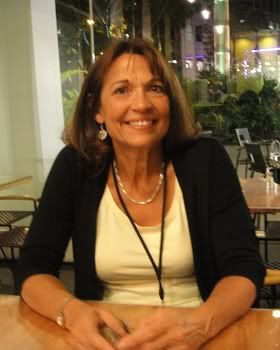Top teacher shares US best practices in deaf education
Donaldson Tan
Meet Susan Elliot. She is an award-winning teacher from Colorado in the United States. She was named the 2009 Colorado State Teacher of the Year and one of four finalists for the 2009 National Teacher of the Year in the USA. Anthony Mullen from Teacher Magazine described her as “bright, articulate, and has a great sense of humour.” She teaches social studies and English language to mainstream and hearing-impaired students-all in the same classroom.
Her ability to teach to both regular and hearing-impaired students in the same classroom is a remarkable display of master teaching. It is hardly surprising that the Ministry of Education (MOE) invited her to attend the 2010 Teacher’s Conference this week, although there was a little controversy over her invitation. MOE originally retracted their invitation upon learning she is deaf and teaches deaf students. After a public outcry over this discrimination, MOE re-invited her again.
During her time here, MOE brought her to visit the deaf schools in Singapore. “These schools are very well-connected to community service organisations,” she observed. She was also impressed at the amount of attention and resources the MOE administration spends on the deaf schools. However, there is room for improvement. Education also exists outside the classroom. Deaf people need access to mass media. In particular, children enjoy watching television programs. The lack of subtitles and sign language interpretor on television actually hinders deaf children from acquiring language. All prime time television in the USA is subtitled with English language and the American Sign Language (ASL).
Having taught for thirty years, she concludes that a customised education for the deaf is probably the best approach. “You don’t force deaf children to fit into the education program. A one-size-fits-all program doesn’t really benefit anybody. It is also important to start early,” she says. Deaf screening of babies in the USA has a success rate of 95%. In the USA, the Home Intervention program under the Individuals with Disabilities Education Act (IDEA) provides parents with free audiologist services to help deaf babies to quickly acquire association to language from their environment. The audiologists also help the parents to overcome their grief due to the discovery of their child’s deafness.
Furthermore, IDEA mandates every public school to create an Individualised Education Program (IEP) for each student who qualifies under both federal and state standards for disability. On top of that, IDEA provides the deaf students with the option of receiving education at home. Such flexibility allows deaf students to learn and integrate with society at their own pace. As a result, there are many deaf students in the USA who actually progressed to higher education. There are many community colleges and universities that accept deaf students in the USA.
In fact, Susan herself is a graduate of Gallaudet University. Access to higher education provides opportunities for deaf people to become gainfully employed as teachers, doctors, lawyers, bankers and other professions. Founded in 1864, Gallaudet University is the world leader in liberal education and career development for deaf and hard of hearing undergraduate students. The university is based in Washington DC. Her higher education qualified her to become a teacher at Highlands Ranch High School where she teaches English language and social studies.
Highlands Ranch High School is a regular school where 1,600 students enrol. The ASL is offered as a foreign language credit there, so deaf and regular students can learn the ASL together. Moreover, there are ASL interpretors in the classroom to assist in the teaching of regular classes. In this way, deaf students are not socially isolated from the community at large. The key enabler is that there is no dearth of ASL interpretors because ASL interpretation is regarded as a profession and not a voluntary task in the USA. Moreover, there are laboratories and workshops at public schools such as Highlands Ranch High School to assist deaf students to identify their affinity for a particular trade skill. “Not every deaf student is suited for university,” says Susan. The diversity of vocational training programs ensures the needs of every deaf student are met.
—
Read also: Deaf children not less deserving, says American teacher.
The video below depicts a reception held in Ole Jim to honor Susan Elliott on March 11, 2009. Ms. Elliott is one of four finalists for the 2009 National Teacher of the Year award. She is also the 2009 Colorado Teacher of the Year. She was also a member of the Gallaudet University’s board of trustee from 1997 to 2004.



[...] also: Top teacher shares US best practices in deaf education by New Asia [...]